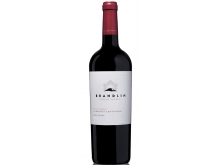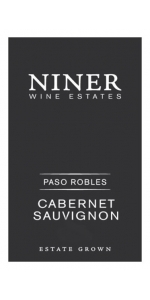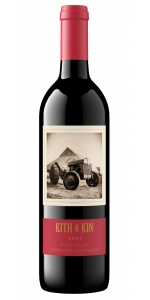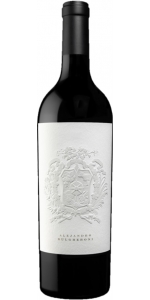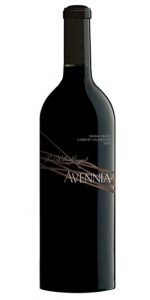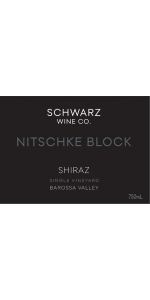Brandlin Estate Cabernet Sauvignon 2016
| Country: | United States |
| Regions: | California California (Napa) |
| Winery: | Brandlin Estate |
| Grape Type: | Cabernet Sauvignon |
| Organic: | Yes |
| Vintage: | 2016 |
| Bottle Size: | 750 ml |
Niner Cabernet Sauvignon is made from 91% Cabernet Sauvignon, 3% Cabernet Franc, 3% Petit Verdot, 3% Malbec.
2021 was a benchmark vintage for Cabernet in Paso Robles. The long, cool growing season was ideal for our Bordeaux grapes and allowed them to slowly ripen, creating complex flavors and wines built to age. The 2021 Cabernet Sauvignon was aged 21 months in French Oak barrels and is one that you’ll want for your collection. It is an elegant wine with a balance of dark fruit flavors and herbaceous notes with lush tannins.
Review:
92 points, Editor's Choice - Wine Enthusiast
Round Pond Estate 'Kith & Kin' Cabernet Sauvignon is made with 85% Cabernet Sauvignon, 9% Petit Verdot, 6% Malbec.
Bursting with bright aromatics of cassis and crushed raspberry, they are balanced with an earthy hint of dried sage and clove. The wine offers an energetic play between acid and tannin on the front palate with notes of blackberry and violet with a touch of cocoa on the mid-palate. Fine-grained tannins follow throughout each sip leading to a long, rich, finish.
Review:
Big and rich, this deeply saturated and mouth-filling wine overflows with ripe, plump blueberries, black currants and black cherries accented with mint and dark chocolate. It’s delicious enough to drink young.
-Wine Enthusiast 92 Points
It is hard to imagine with the Lithology range receiving 298 points out of 300 for the three single-vineyard wines, that there could possibly be a wine above them. But there is, and it is our Estate wine. Blended several times very intently by masters of their craft Philippe Melka and Michel Rolland, this is the ultimate expression of our house’s work. Positive, full-bodied, and quite powerful, there’s the expected crème de cassis and blackberry from St. Helena Cabernets, with mineral, herb, subtle tobacco and vanilla, plum skins, and pie crust, purple flowers, forest-conifer notes, and very fine tannic structure. It is a magnificent, and magnificently elegant expression of this house, and when asked recently, Monsieur Rolland stated plainly to me, “oh yes indeed – this is the best one, the best yet…”
Review:
The flagship 2018 Cabernet Sauvignon Alejandro Bulgheroni comes from a selection made by winemakers Philippe Melka and Michel Rolland, mostly from Rutherford and Oakville fruit. Aged 20 months in 78% new French oak, it has incredible aromatics of black and blue fruits, spring flowers, and graphite to go with a massive, full-bodied, concentrated style on the palate that somehow stays graceful, weightless, and elegant. This tour de force in Napa Valley Cabernet Sauvignon is guaranteed to put a smile on your face over the coming 20-25+ years.
-Jeb Dunnuck 99 Points
It is hard to imagine with the Lithology range receiving 298 points out of 300 for the three single-vineyard wines, that there could possibly be a wine above them. But there is, and it is our Estate wine. Blended several times very intently by masters of their craft Philippe Melka and Michel Rolland, this is the ultimate expression of our house’s work. Positive, full-bodied, and quite powerful, there’s the expected crème de cassis and blackberry from St. Helena Cabernets, with mineral, herb, subtle tobacco and vanilla, plum skins, and pie crust, purple flowers, forest-conifer notes, and very fine tannic structure. It is a magnificent, and magnificently elegant expression of this house, and when asked recently, Monsieur Rolland stated plainly to me, “oh yes indeed – this is the best one, the best yet…”
Review:
Pure perfection in Cabernet, the 2019 Cabernet Sauvignon Alejandro Bulgheroni is all varietal and comes two-thirds from Oakville with the balance from sites in St. Helena and Rutherford. Aged 20 months in 70% new French oak and put together by Philippe Melka and Michel Rolland, it has an incredibly pure, full-bodied, massive yet weightless style that I suspect couldn’t be achieved anywhere outside of Napa Valley. Cassis, blackberries, leafy herbs, lead pencil shavings, and tobacco leaf are just some of the nuances here, and it’s full-bodied, deep, and concentrated on the palate while maintaining an ethereal, seamless, utterly perfect balance between its fruit, alcohol, tannins, and acidity. As good as it gets, it needs just 2-4 years in the cellar and will evolve gracefully for at least 20-25 years.
-Jeb Dunnuck 100 Points
Avennia Red Willow Cabernet Sauvignon is made from 100% Cabernet Sauvignon.
The Red Willow Cabernet is a true blockbuster.
Coming from one specific block of 30 year old vines at this iconic vineyard, then strictly barrel selected, this is the essence of powerful, old vine Washington Cabernet. After all of our efforts promoting the idea of the Bordeaux blend, it would take a pretty compelling argument to suspend that idea and make a 100% varietal Cabernet. In 2016 Red Willow provided us with just that. Each time we tasted it in the barrel, the belief grew that this was something special. Something we can't make every year. In the end we were won over, and decided to make a limited amount of this wine. But don't be fooled, as this too is a blend and a selection. Each year as we are tasting the grapes as harvest approaches, we notice that the vines near the bottom of this long, steep west-facing slope, are a little different. The vines at the bottom are in a little richer soil, and get a little more water, so we pick them separately, sometimes even a week or ten days apart, and keep them separate in barrel.
This wine is all from the top of the vineyard, with its lower yield and poorer soils giving more concentration and interest. Then further, nearly every combination of new and used French oak barrels were trialed to find the best blend. It's not enough just to use the four best barrels, but to trial each combination to see how they complement each other. For a wine with this much mass, 100% new French oak was used for the first time at Avennia. It is a wine that needs a little cellaring to start, but should last a very long time.
Review:
Made from 100% Red Willow Cabernet Sauvignon, the 2016 Cabernet Sauvignon Red Willow is another gem from this great winemaker. Deep purple-colored, with a huge perfume of blackberries, crème de cassis, cedarwood, pencil lead, and graphite, it hits the palate with medium to full-bodied richness and depth, nicely integrated acidity, and building, ripe tannins. Give bottles 3-4 years and it too will cruise for 15-20 years or more.
- Jeb Dunnuck (April 2019), 95 Points
Bursting from the glass with impeccable precision, the 2016 Cabernet Sauvignon Red Willow Vineyard is the real McCoy, boasting a focused frame of fruit on the nose that shows depth and breadth in layers of aromas—blackberry, dark cherry, licorice and clove-laced spices flutter over a bed of roses. I can't stop smelling this wine! Full-bodied, the wine unfolds and expands across the palate with complexity, tight structure and beautifully managed tannins, ending with a thought-provoking and long-lingering finish. The wine has a still-tight expression that will age beautifully for years to come. It will serve you well to seek out a bottle of this world-class wine. Only 140 cases were made.
- Wine Advocate 95 Points
Avennia Red Willow Cabernet Sauvignon is made from 100% Cabernet Sauvignon.
The Red Willow Cabernet is a true blockbuster.
Coming from one specific block of 30 year old vines at this iconic vineyard, then strictly barrel selected, this is the essence of powerful, old vine Washington Cabernet. After all of our efforts promoting the idea of the Bordeaux blend, it would take a pretty compelling argument to suspend that idea and make a 100% varietal Cabernet. In 2016 Red Willow provided us with just that. Each time we tasted it in the barrel, the belief grew that this was something special. Something we can't make every year. In the end we were won over, and decided to make a limited amount of this wine. But don't be fooled, as this too is a blend and a selection. Each year as we are tasting the grapes as harvest approaches, we notice that the vines near the bottom of this long, steep west-facing slope, are a little different. The vines at the bottom are in a little richer soil, and get a little more water, so we pick them separately, sometimes even a week or ten days apart, and keep them separate in barrel.
This wine is all from the top of the vineyard, with its lower yield and poorer soils giving more concentration and interest. Then further, nearly every combination of new and used French oak barrels were trialed to find the best blend. It's not enough just to use the four best barrels, but to trial each combination to see how they complement each other. For a wine with this much mass, 100% new French oak was used for the first time at Avennia. It is a wine that needs a little cellaring to start, but should last a very long time.
Review:
"The 2016 Cabernet Sauvignon Red Willow Vineyard is 100% Red Willow Cabernet Sauvignon that will spend roughly 20 months in close to 100% new French oak. Blackcurrants, smoked herbs, chocolate, and graphite notes all give way to a full-bodied, plump, rich, concentrated effort that's going to be better with short-term cellaring and keep for two decades."
- Jeb Dunnuck (April 2018), 94-96 pts
Brandlin Estate Cabernet Sauvignon is made from 76% Cabernet Sauvignon 12% Malbec 7% Cabernet Franc 2% Petit Verdot.
The 2016 vintage was a near perfect year, producing wines of opulence and intensity. The terroir of the Brandlin vineyard naturally thickens the grape skins, developing deep color and tannin while also creating remarkably small berries. Our 2016 Estate Cabernet Sauvignon offers inky, dark fruit, and a plush mouthfeel while boasting notes of blackberry, mocha, fig, dates and dense black currant fruit accented with hints of nettle, earth and clove.
Brandlin is a Napa Valley estate that produces wine from a small, historic vineyard in the Mount Veeder appellation. The wines pay homage to the Brandlin family. As early as the 1870s, the Brandlins settled on these steep, rocky slopes, and became grape growing pioneers in Napa's Mount Veeder region. With over 50 years' of experience, Henry Brandlin staked the family’s claim to this estate and planted their own vineyards in 1926.In 1998 Cuvaison Estate Wines was honored by Henry’s son, Chester Brandlin, with rights to purchase Brandlin Vineyard. Respectfully maintaining the integrity of the estate, only a fraction of the land has been planted to vineyards carefully designed to honor the integral beauty of the property. Glens of old oak trees and sustainable viticultural practices support natural biodiversity and abundant wildlife.We brought to Brandlin Vineyard all the lessons of Cuvaison Estate Wines' 38 years of viticulture - great care in the study of sun exposures and soil types, and profound respect for the environment. Our intention is to honor the Brandlin family with a namesake vineyard that produces intense and elegant Cabernet Sauvignon. - Steven Rogstad, Winemaker
Review:
This has the expressive fruit and racy spine of the vintage, mixing plum and blackberry paste flavors with a graphite edge, while extra sassafras and bramble notes add energy to the finish. Solid. Best from 2022 through 2032. Tasted twice, with consistent notes. 2,226 cases made.
-Wine Spectator 93 Points
Brandlin is a Napa Valley estate that produces wine from a small, historic vineyard in the Mount Veeder appellation. The wines pay homage to the Brandlin family. As early as the 1870s, the Brandlins settled on these steep, rocky slopes, and became grape growing pioneers in Napa's Mount Veeder region. With over 50 years' of experience, Henry Brandlin staked the family’s claim to this estate and planted their own vineyards in 1926.In 1998 Cuvaison Estate Wines was honored by Henry’s son, Chester Brandlin, with rights to purchase Brandlin Vineyard. Respectfully maintaining the integrity of the estate, only a fraction of the land has been planted to vineyards carefully designed to honor the integral beauty of the property. Glens of old oak trees and sustainable viticultural practices support natural biodiversity and abundant wildlife.We brought to Brandlin Vineyard all the lessons of Cuvaison Estate Wines' 38 years of viticulture - great care in the study of sun exposures and soil types, and profound respect for the environment. Our intention is to honor the Brandlin family with a namesake vineyard that produces intense and elegant Cabernet Sauvignon. - Steven Rogstad, Winemaker
Schwarz Nitschke Block Shiraz is made from 100 percent Shiraz.
This Bethany vineyard was planted by Jason Schwarz's parents in 1968 and has been tended to by the hands of his family ever since. The vines are dry-grown and produce small crops of intensely flavored fruit.
A display of the purest blood-plum and black cherry, with cracked black peppercorn and streaky bacon over some seriously fine oak. Some subtle herbaceous qualities, nettle and thyme bring life to an otherwise immense nose. Very juicy on the palate, deeply flavorsome, long and with mouth-coating tannin for a very textured, very focused Barossa classic.
Slow cooked beef ribs, grilled meats, wild game and grilled vegetables.
Review:
"All the good stuff: dry-grown and fermented under the aegis of wild yeast; a smattering of whole-bunch seasoning (25%), French oak (20% new), conferring poise, freshness and authority. As far as Barossa shiraz goes, this is benchmark. Plush but nicely taut. A stream of boysenberry fruit and violet scents sashay to a samba of thyme, tapenade and smoked meats, nicely avoiding any sense of reduction, or clunky jam. This is smart. Very. - Ned Goodwin"
- Halliday Wine Companion (August 2020), 96 pts
- back
Double Diamond Oakville Proprietary Red is made from 50% Cabernet Sauvignon, 25% Merlot, and 25% Cabernet Franc.
"The inaugural release of the 2021 Proprietary Red Wine upholds the level of excellence expected from winemaker Thomas Rivers Brown. It expresses a fragrant perfume of ripe red cherry, blueberry, and pomegranate, mingled with bell pepper, iron, and vanilla bean. On the palate, generous red and blue fruits are complemented by blackberry compote, dark chocolate, and espresso. The wine has silky tannins, food-friendly acidity, and a lingering finish. It is ready to drink upon release but will cellar well for years to come."
Ambre de Maltus Bordeaux Blanc is made from 70% Sauvignon Blanc, 30% Sémillion.
Malolactic fermentation.
The wine was aged in French Oak barrels for a few month (between 6 and 8 months depending on the barrel's toastiness and cooper)
Delicious with grilled fish or grilled vegetables

